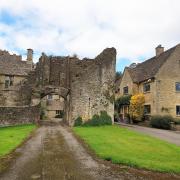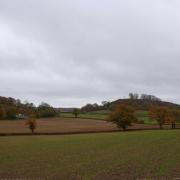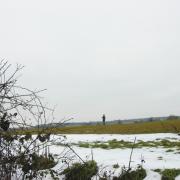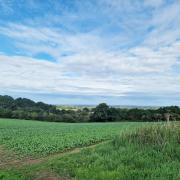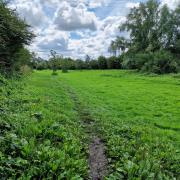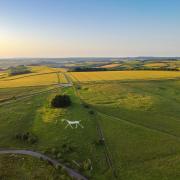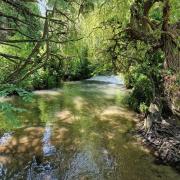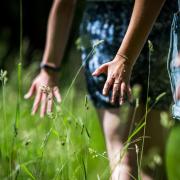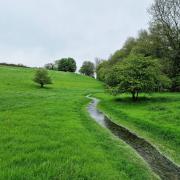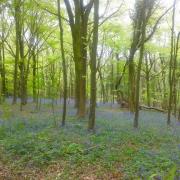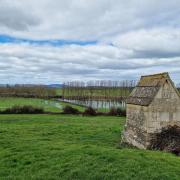A circular walk through beautiful scenery of the high Cotswold, culminating in a visit to one of the region’s most renowned ancient monuments
Belas Knap, situated on a hilltop above Winchcombe, is the most impressive of the Cotswold-Severn style of Neolithic long barrows. It was beautifully restored following its excavation in the 1860s and 1920s. Five thousand years old, it must have a few stories to tell, but – as with many prehistoric monuments in England – no ancient legend about the place has survived. Its folklore, instead, concerns strange things people have experienced there in modern times. If you park in the lane below the monument, a circular walk via the curiosities of the nearby hamlet of Postlip will lead you to a splendid view of Belas Knap before you arrive there to discover your own experience of the place.

From the layby where our walk begins, there’s an expansive view down across Winchcombe and Sudeley Castle. Crossing the nearby T-junction, take the gate into the field beyond and proceed along its left-hand edge. The right of way crosses the drive to Corndean Hall and continues beside a wood – which has materialised since our map was printed – and then across a field. At a crossroads of tracks, carry straight on.
Suddenly, you find yourself in the industrial landscape of Postlip paper mill, today run by Hollingsworth & Vose. There’s been a working mill on this site on the river Isbourne since the Norman Conquest. It’s been a paper mill for 300 years. As you make your way through the well-waymarked site, you’ll see the 19th-century mill buildings, dwarfed by the modern structures alongside them.

The mill was owned by a succession of families – the Durhams, the Lloyds, the Adlards. When one Mr Adlard died, and his workers all trooped past the body to pay their respects, each of them touched his hand. When his daughter asked the foreman why, he said that it was to stop Adlard’s spirit haunting them.
Emerging from the industrial site, take the Isbourne Way left, over the diminutive Isbourne, and then right, across some bare ground, to where the path appears to fork three ways. Like Thomas the Rhymer heading to fair Elfland, choose the middle path into a wood. Cross a tiny footbridge into a field and walk along the south bank of the stream, with tantalising glimpses of beautiful pools to which there’s no public access.
READ MORE: Witchcraft and necromancy in Long Compton.

You then intersect a track that leads to Postlip Hall the other side of the stream. Originally built in the 16th and 17th centuries, the Hall is now the home of a radical co-housing community. Bought for a mere £20,000 in the 1960s by a group of friends who wanted to bring up their families together, it remains a working community to this day. They host a range of public events, including a beer festival in July.
Follow the Cotswold Way straight ahead along the wall of the grounds. You may want to climb up the hill a bit to get a better view of Postlip Hall! You’ll also see, nearer the wall, a large 14th-century tithe barn. On the top of its gable stands a weather-eroded figure. This is supposedly a naked statue of William de Postlip, a renegade landowner of the reign of Edward I; his lands were confiscated after he committed a felony. He’s still a bit of a scamp even in stone: the naked knight skips down from his perch on moonlit nights when he hears the chapel bell toll midnight and goes and takes a drink at a wishing well.

This well is, we think, the stone-hooded well you’ll see on your left as you continue, keeping right, along the Cotswold Way. Soon afterwards, you come to a door in the wall on your right. The door is locked but you can peer over to see the chapel of St James. This was built by an earlier landowner, William de Solers, at the request of his tenants who, during the Anarchy of King Stephen’s reign in the 12th century*, were getting robbed on the road to Winchcombe when they went to Mass there. For centuries after the Reformation the chapel was used as a barn until, at the behest of Elizabeth Forster, the Hall’s incumbent in 1890, the local architect Henry Prothero restored it in eye-watering neo-Gothic style as a Roman Catholic church. Infrequent services continue to take place here for the faithful.
Retrace your steps to the crossroads and then turn right, still on the Cotswolds Way. If you look back as you gain height up the hill, you’ll get further good views of Postlip Hall. From here on, the Cotswold Way is well signposted through a succession of lovely woods and fields. For the last half mile before Belas Knap you’ll have a clear view of the monument on its hilltop site.

Today Belas Knap is backed by trees to the east, but one visitor was granted a different perspective of the landscape. Seeing a procession of cowled figures approaching the barrow, she shyly moved some distance away so they could do whatever they’d come to do. But the figures vanished. When the woman returned to the monument, she noticed that the field pattern had changed and there were fewer trees. It was as if, as Mark Turner puts it, she’d looked through a window in time.
A family enjoying a picnic at Belas Knap had the startling experience of their tablecloth suddenly rising into the air, despite the weight of dishes upon it, and scattering everything on the ground. Another couple saw orbs of green light and when they sat in one of the four burial chambers cut into the sides of the barrow they felt an intense tingling sensation and heard a rhythmic drumming sound outside. Such a tingling sensation sounds like a sign of the mystical energy often said to be associated with ancient sacred sites.
Julian Cope interprets the ground plan of long barrows like Belas Knap as symbolically representing a recumbent woman: the entrance symbolises the vulvic opening between parted legs, and thus the dead taken inside for burial are ritually returned into the womb of Mother Earth. In the case of Belas Knap, the impressive ‘entrance’ is something of a façade, although the remains of five people were found buried behind it. Presumably rituals would have been conducted in front of it, and there’s a theory it might have been regarded as a ‘spirit door’ through which the spirits of the dead would come and go to receive offerings. Whatever you make of such speculations, they do give you something to think about as you stand between the ‘legs’ of the blocked-up opening. They might even provoke a bit of tingling.
*See Stephen Roberts' feature on Anarchy in the Cotswolds, 12th-century style, in this issue.
ESSENTIALS
Distance: 5.5 miles.
Duration: 3 hours.
Level: Easy footpaths and stiles, with one fairly steep ascent.
Parking: Roadside layby opposite the sign to Belas Knap (grid reference 020263).
Toilets and refreshments: Head to Winchcombe for pubs and cafes galore.
Transport links: To Winchcombe on the No. 606 bus from Chipping Campden/Bishop’s Cleeve or the W from Cheltenham; then a mile’s walk up the road to the start of the walk
Map: OS Outdoor Leisure 45 The Cotswolds.
Further reading: The Modern Antiquarian, by Julian Cope; Mysterious Gloucestershire, by Mark Turner.
Acknowledgements: Thanks for help and inspiration to Mark Grassick and Laura Kinnear.
LINKS
- Route: gb.mapometer.com/walking/route_5372210
- Belas Knap: www.english-heritage.org.uk/visit/places/belas-knap-long-barrow
- Postlip Hall: postliphall.org.uk
Kirsty Hartsiotis and Anthony Nanson are based in Stroud and available for hire as storytellers and speakers. Their books include Gloucestershire Folk Tales, Wiltshire Folk Tales, Gloucestershire Ghost Tales, and Gloucestershire Folk Tales for Children. Kirsty is also the curator of decorative and fine art at a Gloucestershire museum. Anthony runs the small press Awen Publications.
SUBSCRIBE to Cotswold Life magazine for more folkloric walks.






